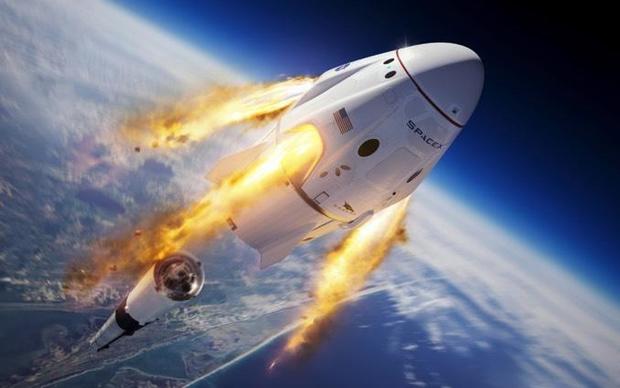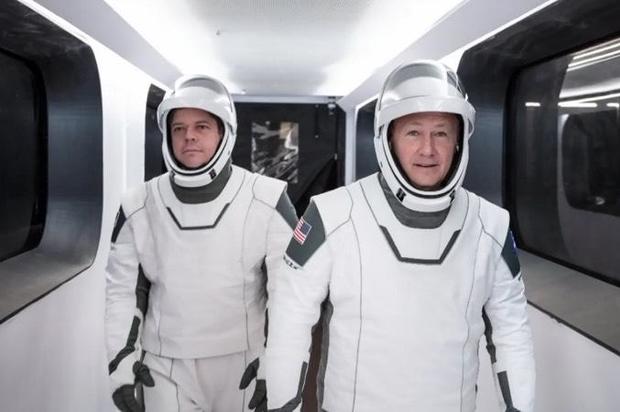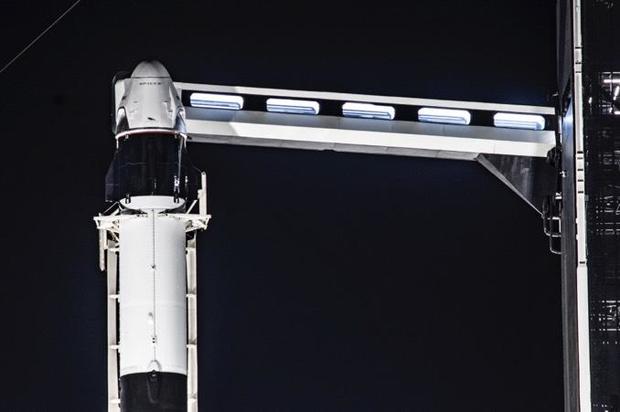The launch of a SpaceX Falcon 9 rocket on a dramatic in-flight test of the emergency escape system built into the company's Crew Dragon astronaut ferry ship was delayed 24 hours on Saturday because of high winds and rough seas in the capsule's off-shore recovery zone.
The Falcon 9, featuring a thrice-flown first stage and a fueled but engine-less second stage, is expected to be destroyed during the test while the unpiloted Crew Dragon capsule, equipped with eight powerful Super Draco rocket engines, is boosted to safety before splashing down about 20 miles northeast of Cape Canaveral.
Launch from historic pad 39A at the Kennedy Space Center originally was targeted for 8 a.m. ET Saturday, the opening of a four-hour window. But forecasters warned that expected high winds and rough seas off shore could cause problems for the Crew Dragon's recovery.
Mission managers later pushed launch back to the end of the window, and early Saturday, SpaceX tweeted the launch would be delayed 24 hours.
Trending News
"Standing down from today's in-flight Crew Dragon launch escape test attempt due to sustained winds and rough seas in the recovery area," SpaceX announced. "Now targeting Sunday, January 19, with a six-hour test window opening at 8:00 a.m. EST."
Off-shore weather should be better Sunday, but upper level clouds ahead of a cold front could still cause problems.
"Recovery weather is great," said launch weather officer Mike McAleenan. "Very light winds and very low waves. Unfortunately, that front is moving into the panhandle of Florida, and we're going to see a lot of upper level clouds moving into our areas. You can see that's not good for (recovery visibility), and it's not too good for launch weather."
The in-flight abort test, or IFAT, is the last major milestone before SpaceX launches two veteran NASA astronauts -- Doug Hurley and Bob Behnken -- on a flight to the International Space Station, the first launch of U.S. astronauts from American soil since the space shuttle's final mission in 2011.
If the test goes well, and assuming no other major issues crop up, the long-awaited piloted test flight with Hurley and Behnken, known as Demo-2, could come as early as March.
"The vehicle will be all ready at the end of February," Kathy Lueders, manager of NASA's Commercial Crew Program, told reporters Friday. "We're kind of shooting for early March right now, from a planning perspective. That would be the earliest."
Boeing also is building a commercial crew capsule for NASA — the CST-100 Starliner — but it's not yet clear when that ship will be ready for a piloted test flight to the space station. Boeing launched a Starliner last month on an unpiloted test flight, but an on-board timing glitch prevented a rendezvous and docking with the space station.
SpaceX flew its own unpiloted Crew Dragon test flight last March, docking with the station and safely returning to Earth. At that point, the in-flight abort test was planned for last spring with the first piloted mission expected in the summer-to-fall timeframe.
But last April, a Crew Dragon exploded during a ground test, an instant before ignition of its Super Draco abort engines, and downstream tests were delayed.
The failure later was blamed on a leaky valve in the propellant pressurization system and the design was modified to prevent any chance of a recurrence. The system was successfully tested last November, clearing the way for the in-flight abort test.
Hurley and Behnken, both spaceflight veterans, flew in from the Johnson Space Center to participate in the countdown rehearsal Friday and both planned to be on hand in the SpaceX launch control center when the Falcon 9 and its unpiloted Crew Dragon blast off.
The importance of a reliable abort system was dramatically demonstrated last October when a Russian booster suffered a catastrophic malfunction two minutes after liftoff. The Soyuz spacecraft carrying a Russian cosmonaut and his NASA co-pilot automatically aborted, landing about 200 miles downrange from the Baikonur Cosmodrome in Kazakhstan.
"We were ripped away from the rocket while it's disintegrating and continuing to burn and pulled away to safety," astronaut Nick Hague told CBS News. "You realize in that moment, 'hey, this could have been really bad.'"
How the test flight will work
The initial moments of Sunday's flight will follow a normal Falcon 9 space station launch trajectory. But not for long.
As the rocket plows upward through the thick lower atmosphere, the region where aerodynamic stress is most severe, the on-board flight computer was programmed to trigger the abort about 84 seconds after liftoff, just as it would in a piloted flight if sensors detected an impending malfunction.
The Falcon's engines will shut down as the Crew Dragon's eight Super Draco abort engines ignite, pushing the capsule away from the now-powerless booster with an acceleration a race car driver would envy. Within just a few seconds, the spacecraft will reach a relative velocity of some 430 mph, subjecting two heavily instrumented astronaut test dummies to more than four times the normal force of gravity.
With its own engines shut down, the booster is expected to aerodynamically break up, showering debris into the Atlantic Ocean below. SpaceX recovery crews will be standing by just outside the designated safety zone to clean up as much of the debris as possible.
"The Dragon will have left, so the top end of the second stage is now basically a big air scoop," said Benji Reed, SpaceX director of crew mission management. "And so you've got all this air pushing against it, a huge amount of force pushing against it ... so it's going to be a lot more susceptible to the winds as it loses its velocity and start to tumble.
"At some point, we expect that the Falcon will start to break up. And yes, both stages are loaded with fuel because we want to have the right mass and do the test the right way. So with both stages loaded with fuel, there'll probably be some amount of ignition, flame, we'll see something. ... But we do expect it to break up."
The Crew Dragon, meanwhile, was programmed to jettison its no-longer-needed lower trunk section before flipping around, putting its heat shield in the direction of travel, arcing over at an altitude of about 26 miles and plunging back into the lower atmosphere.
If all goes well, two drogue chutes will deploy at an altitude of about three miles, stabilizing the ship and slowing it down before the Crew Dragon's four main parachutes deploy about a minute later at an altitude of just one mile or so. From there, the ship should descend to a relatively gentle splashdown about 20 miles east of Cape Canaveral.
A SpaceX recovery ship will be standing by to haul the craft on board and bring it back to Port Canaveral. Total test duration from launch to splashdown: about 10 minutes.
The abort systems in the Crew Dragon and Boeing's Starliner are both designed to carry the capsules to safety in the event of a catastrophic failure at any point from the launch pad to orbit, resulting in emergency splashdowns. Launches to the space station require trajectories that parallel the East Coast and an abort could result in a splashdown at any point from Cape Canaveral to the North Atlantic Ocean.
For normal SpaceX splashdowns and Boeing landings in the western United States, both companies are responsible for recovering their own spacecraft and getting the crews back to NASA. For emergency rescue scenarios, all of which end with unplanned ocean splashdowns, NASA is relying on the U.S. Air Force.
For all piloted launches of Crew Dragon and Starliner spacecraft, two HH-60 Pave Hawk helicopters and an extended-range HC-130 aircraft will be on standby at nearby Patrick Air Force Base, ready to deploy rescue crews, rafts and equipment within 230 miles of the launch site.
For near-shore aborts, the astronauts would be flown back to land by helicopter or taken directly to a trauma center if necessary.
"Other crews will be on standby in Charleston, South Carolina, where a C-17 (jet) will be ready for takeoff," Steve Payne, manager of commercial crew launch integration for NASA, said in an interview. "They can go fly out to wherever we are in the middle of the ocean, drop equipment and rescue jumpers and get the crew stabilized and then wait for a ... vessel of opportunity to come help out."
Once a commercial crew ship reaches orbit, the Air Force will maintain the rescue alert team at Charleston and another a Hickham Air Force Base in Hawaii to provide assistance in the event of problems that might force an unplanned landing.
https://news.google.com/__i/rss/rd/articles/CBMihQFodHRwczovL3d3dy5jYnNuZXdzLmNvbS9uZXdzL3NwYWNleC1mYWxjb24tOS1yb2NrZXQtbGF1bmNoLWluLWZsaWdodC1hYm9ydC10ZXN0LXRvLXByb3ZlLWNyZXctc2hpcC1zYWZlLXdhdGNoLWxpdmUtc3RyZWFtLTIwMjAtMDEtMTgv0gGJAWh0dHBzOi8vd3d3LmNic25ld3MuY29tL2FtcC9uZXdzL3NwYWNleC1mYWxjb24tOS1yb2NrZXQtbGF1bmNoLWluLWZsaWdodC1hYm9ydC10ZXN0LXRvLXByb3ZlLWNyZXctc2hpcC1zYWZlLXdhdGNoLWxpdmUtc3RyZWFtLTIwMjAtMDEtMTgv?oc=5
2020-01-18 12:05:00Z
52780557606718



Tidak ada komentar:
Posting Komentar